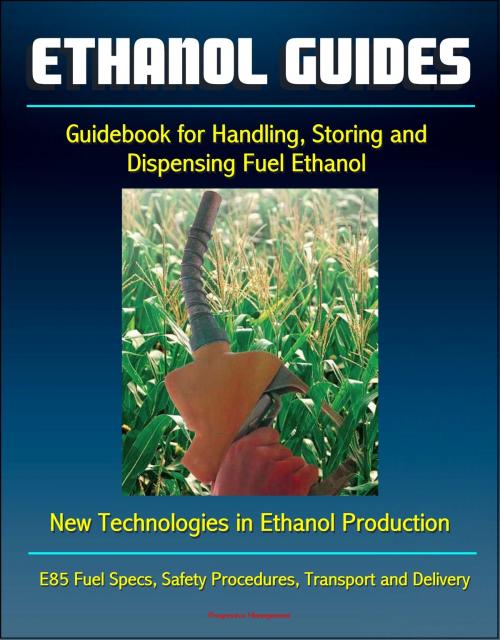Ethanol Guides: Guidebook for Handling, Storing and Dispensing Fuel Ethanol - New Technologies in Ethanol Production - E85 Fuel Specs, Safety Procedures, Transport and Delivery
Nonfiction, Science & Nature, Technology, Power Resources| Author: | Progressive Management | ISBN: | 9781301108695 |
| Publisher: | Progressive Management | Publication: | June 6, 2013 |
| Imprint: | Smashwords Edition | Language: | English |
| Author: | Progressive Management |
| ISBN: | 9781301108695 |
| Publisher: | Progressive Management |
| Publication: | June 6, 2013 |
| Imprint: | Smashwords Edition |
| Language: | English |
Two important publications by the U.S. Department of Energy provide great information about ethanol. Guidebook for Handling, Storing and Dispensing Fuel Ethanol - This guidebook is intended as firsthand information for fuel distributors and retailers who have not had any experience or formal training with ethanol fuels. The first three chapters contain information about government regulations, ethanol-fueled vehicles, and fuel standards, which may also be useful to fleet managers and ethanol fuel users. The rest of the handbook addresses material recommendations, parts and equipment, and handling and delivery of ethanol fuel. Contents: WHY FUEL ETHANOL? * ENERGY POLICY ACT OF 1992 * ALCOHOL-FUELED VEHICLES * PRODUCTION, PROPERTIES, & ENVIRONMENTAL IMPACTS * Production * Physical Properties * Emissions * E85 FUEL SPECIFICATIONS & STANDARDS * ASTM Fuel Standard Specification * Seasonally Adjusted Blend * Hydrocarbons * Fuel Additives * E85 QUALITY ASSURANCE * MATERIALS RECOMMENDATIONS * FUEL STORAGE & DISPENSING * General Dispensing Equipment * Aboveground Fuel-Storage Systems * Underground Fuel-Storage Systems * FUEL TRANSPORT & DELIVERY * HANDLING FUEL ETHANOL * Visual Inspection * Hydrocarbon Content of the Fuel Ethanol * Electrical Conductivity * SAFETY PROCEDURES * Health Considerations * Fire Safety Considerations * Safety Codes
New Technologies in Ethanol Production - Fuel ethanol production has increased steadily in the United States since the 1980s, when it was given impetus by the need to reduce energy dependence on foreign supplies. The momentum has continued as production costs have fallen, and as the U.S. Clean Air Act has specified a percentage of renewable fuels to be mixed with gasoline. The fraction of annual U.S. corn production used to make ethanol rose from around 1 percent in 1980 to around 20 percent in 2006, and ethanol output rose from 175 million gallons to about 5.0 billion gallons over the same period. New technologies that may further increase cost savings include coproduct development, such as recovery of high-value food supplements, and cellulosic conversion. High oil prices may spur the risk-taking needed to develop cellulose-to-ethanol production. Developments such as dry fractionation technology, now commercially viable, may alter the structure of the industry by giving the cheaper dry-grind method an edge over wet milling. Dry milling requires smaller plants, and local farmer cooperatives could flourish as a result. Though improvements in processing and technology are important, however, the fluctuating price of inputs such as corn, the cost of energy alternatives, and environmental developments play larger roles in the fortunes of the industry. Changes Since the 1993 ERS Analysis of Ethanol Production * Ethanol's Energy Efficiency * Ethanol Production Processes * Input Improvements: Higher-Ethanol-Yielding Corn * Process Improvements * Advances in Separation Technologies * New Ways of Fermentation * New Enzymes * Distillation Technology * Control Systems * Environmental Technologies * Technologies Involving Coproducts * The Growing Supply of Feed Coproducts * Sequential Extraction * Corn Germ Recovery for the Dry-Mill Process * Centrifugal Corn Oil Separation from the Distiller's Grain Stream * CO2 Recovery * Stillage Clarification and Other Uses of Membranes * Biorefinery * Extraction of Compounds from DDGS * Corn Fiber Oil Recovery * Regional Impacts of Ethanol Plants * National Benefits from Ethanol * Biomass: Ethanol's Future? * Cellulose to Ethanol: The Process * Supplying Biomass * Biomass Byproducts: Problems with Acid and High Temperatures * Other Biomass-to-Ethanol Improvements * Conclusions: Ethanol's Potential
Two important publications by the U.S. Department of Energy provide great information about ethanol. Guidebook for Handling, Storing and Dispensing Fuel Ethanol - This guidebook is intended as firsthand information for fuel distributors and retailers who have not had any experience or formal training with ethanol fuels. The first three chapters contain information about government regulations, ethanol-fueled vehicles, and fuel standards, which may also be useful to fleet managers and ethanol fuel users. The rest of the handbook addresses material recommendations, parts and equipment, and handling and delivery of ethanol fuel. Contents: WHY FUEL ETHANOL? * ENERGY POLICY ACT OF 1992 * ALCOHOL-FUELED VEHICLES * PRODUCTION, PROPERTIES, & ENVIRONMENTAL IMPACTS * Production * Physical Properties * Emissions * E85 FUEL SPECIFICATIONS & STANDARDS * ASTM Fuel Standard Specification * Seasonally Adjusted Blend * Hydrocarbons * Fuel Additives * E85 QUALITY ASSURANCE * MATERIALS RECOMMENDATIONS * FUEL STORAGE & DISPENSING * General Dispensing Equipment * Aboveground Fuel-Storage Systems * Underground Fuel-Storage Systems * FUEL TRANSPORT & DELIVERY * HANDLING FUEL ETHANOL * Visual Inspection * Hydrocarbon Content of the Fuel Ethanol * Electrical Conductivity * SAFETY PROCEDURES * Health Considerations * Fire Safety Considerations * Safety Codes
New Technologies in Ethanol Production - Fuel ethanol production has increased steadily in the United States since the 1980s, when it was given impetus by the need to reduce energy dependence on foreign supplies. The momentum has continued as production costs have fallen, and as the U.S. Clean Air Act has specified a percentage of renewable fuels to be mixed with gasoline. The fraction of annual U.S. corn production used to make ethanol rose from around 1 percent in 1980 to around 20 percent in 2006, and ethanol output rose from 175 million gallons to about 5.0 billion gallons over the same period. New technologies that may further increase cost savings include coproduct development, such as recovery of high-value food supplements, and cellulosic conversion. High oil prices may spur the risk-taking needed to develop cellulose-to-ethanol production. Developments such as dry fractionation technology, now commercially viable, may alter the structure of the industry by giving the cheaper dry-grind method an edge over wet milling. Dry milling requires smaller plants, and local farmer cooperatives could flourish as a result. Though improvements in processing and technology are important, however, the fluctuating price of inputs such as corn, the cost of energy alternatives, and environmental developments play larger roles in the fortunes of the industry. Changes Since the 1993 ERS Analysis of Ethanol Production * Ethanol's Energy Efficiency * Ethanol Production Processes * Input Improvements: Higher-Ethanol-Yielding Corn * Process Improvements * Advances in Separation Technologies * New Ways of Fermentation * New Enzymes * Distillation Technology * Control Systems * Environmental Technologies * Technologies Involving Coproducts * The Growing Supply of Feed Coproducts * Sequential Extraction * Corn Germ Recovery for the Dry-Mill Process * Centrifugal Corn Oil Separation from the Distiller's Grain Stream * CO2 Recovery * Stillage Clarification and Other Uses of Membranes * Biorefinery * Extraction of Compounds from DDGS * Corn Fiber Oil Recovery * Regional Impacts of Ethanol Plants * National Benefits from Ethanol * Biomass: Ethanol's Future? * Cellulose to Ethanol: The Process * Supplying Biomass * Biomass Byproducts: Problems with Acid and High Temperatures * Other Biomass-to-Ethanol Improvements * Conclusions: Ethanol's Potential















